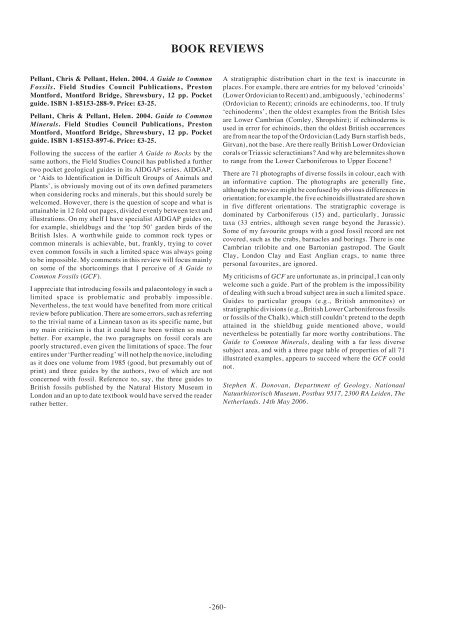Continental trace fossils and museum exhibits - Geological Curators ...
Continental trace fossils and museum exhibits - Geological Curators ...
Continental trace fossils and museum exhibits - Geological Curators ...
You also want an ePaper? Increase the reach of your titles
YUMPU automatically turns print PDFs into web optimized ePapers that Google loves.
BOOK REVIEWSPellant, Chris & Pellant, Helen. 2004. A Guide to CommonFossils. Field Studies Council Publications, PrestonMontford, Montford Bridge, Shrewsbury, 12 pp. Pocketguide. ISBN 1-85153-288-9. Price: £3-25.Pellant, Chris & Pellant, Helen. 2004. Guide to CommonMinerals. Field Studies Council Publications, PrestonMontford, Montford Bridge, Shrewsbury, 12 pp. Pocketguide. ISBN 1-85153-897-6. Price: £3-25.Following the success of the earlier A Guide to Rocks by thesame authors, the Field Studies Council has published a furthertwo pocket geological guides in its AIDGAP series. AIDGAP,or ‘Aids to Identification in Difficult Groups of Animals <strong>and</strong>Plants’, is obviously moving out of its own defined parameterswhen considering rocks <strong>and</strong> minerals, but this should surely bewelcomed. However, there is the question of scope <strong>and</strong> what isattainable in 12 fold out pages, divided evenly between text <strong>and</strong>illustrations. On my shelf I have specialist AIDGAP guides on,for example, shieldbugs <strong>and</strong> the ‘top 50’ garden birds of theBritish Isles. A worthwhile guide to common rock types orcommon minerals is achievable, but, frankly, trying to covereven common <strong>fossils</strong> in such a limited space was always goingto be impossible. My comments in this review will focus mainlyon some of the shortcomings that I perceive of A Guide toCommon Fossils (GCF).I appreciate that introducing <strong>fossils</strong> <strong>and</strong> palaeontology in such alimited space is problematic <strong>and</strong> probably impossible.Nevertheless, the text would have benefited from more criticalreview before publication. There are some errors, such as referringto the trivial name of a Linnean taxon as its specific name, butmy main criticism is that it could have been written so muchbetter. For example, the two paragraphs on fossil corals arepoorly structured, even given the limitations of space. The fourentires under ‘Further reading’ will not help the novice, includingas it does one volume from 1985 (good, but presumably out ofprint) <strong>and</strong> three guides by the authors, two of which are notconcerned with fossil. Reference to, say, the three guides toBritish <strong>fossils</strong> published by the Natural History Museum inLondon <strong>and</strong> an up to date textbook would have served the readerrather better.A stratigraphic distribution chart in the text is inaccurate inplaces. For example, there are entries for my beloved ‘crinoids’(Lower Ordovician to Recent) <strong>and</strong>, ambiguously, ‘echinoderms’(Ordovician to Recent); crinoids are echinoderms, too. If truly‘echinoderms’, then the oldest examples from the British Islesare Lower Cambrian (Comley, Shropshire); if echinoderms isused in error for echinoids, then the oldest British occurrencesare from near the top of the Ordovician (Lady Burn starfish beds,Girvan), not the base. Are there really British Lower Ordoviciancorals or Triassic scleractinians? And why are belemnites shownto range from the Lower Carboniferous to Upper Eocene?There are 71 photographs of diverse <strong>fossils</strong> in colour, each withan informative caption. The photographs are generally fine,although the novice might be confused by obvious differences inorientation; for example, the five echinoids illustrated are shownin five different orientations. The stratigraphic coverage isdominated by Carboniferous (15) <strong>and</strong>, particularly, Jurassictaxa (33 entries, although seven range beyond the Jurassic).Some of my favourite groups with a good fossil record are notcovered, such as the crabs, barnacles <strong>and</strong> borings. There is oneCambrian trilobite <strong>and</strong> one Bartonian gastropod. The GaultClay, London Clay <strong>and</strong> East Anglian crags, to name threepersonal favourites, are ignored.My criticisms of GCF are unfortunate as, in principal, I can onlywelcome such a guide. Part of the problem is the impossibilityof dealing with such a broad subject area in such a limited space.Guides to particular groups (e.g., British ammonites) orstratigraphic divisions (e.g., British Lower Carboniferous <strong>fossils</strong>or <strong>fossils</strong> of the Chalk), which still couldn’t pretend to the depthattained in the shieldbug guide mentioned above, wouldnevertheless be potentially far more worthy contributions. TheGuide to Common Minerals, dealing with a far less diversesubject area, <strong>and</strong> with a three page table of properties of all 71illustrated examples, appears to succeed where the GCF couldnot.Stephen K. Donovan, Department of Geology, NationaalNatuurhistorisch Museum, Postbus 9517, 2300 RA Leiden, TheNetherl<strong>and</strong>s. 14th May 2006.-260-
















